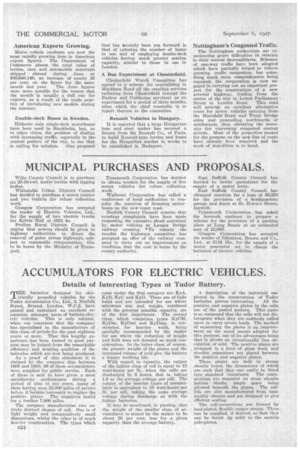ACCUMULATORS FOR ELECTRIC VEHICLES.
Page 42

If you've noticed an error in this article please click here to report it so we can fix it.
Details of Interesting Types ot Tudor Battery.
MHE batteries designed for elec trically propelled Vehicles by the Tudor Accumulator Co., Ltd., 2, Norfolk Street, Strand, London, W.C.2, have gained and sustained an excellent reputatien emoegst users of battery-electric vehicles. This is only natural, when one considers that the company has specialized in the manufacture of this class of article for the past eighteen years or more. That this lengthy experience has been turned to good purpose may be judged from the remarkable efficiency and wearing qualities of the. batteries which are now being produced. As a proof, of this statement it is claimed by the company that between 1907 and 11/10, 26 of these accumulators were supplied for public service. Each of these is said to have given a most satisfactory performance during a period of nine to ten years, many of them having seen 15,000 miles of service before it becanie neeessarY to replace the positive platee. The negatives lasted for a fnrther 7,000 miles.
The company manufactures two entirely distinct classes of cell. One is of light weight and comparatively small dimensions, whilst the other is of much hen vier construction. The types which
come under the first category are KyA, KyD, KyC and ICyD. These are of light build and are intended for use where minimum size and weight, combined with the greatest possible capacity, are of the first importance. The second class. 'which .comprises types Ky0141, KyLien, KyDmi and KyDmp, is constructed, for heavier work, being specially recommended by the maker for use where the reduction of weight and bulk does not demand so much consideration. In the latter class, of course, the greater weight of the plates and the increased volume of acid give the battery a longer working life.
With regard to capacity, the output of the lighter class of cell is equal to 12 watt-hours per lb., when the cells are discharged in 5 hours, that is, taking 1.9 as the average voltage per cell. The output of the heavier types of accumulator is equivalent to 10 watt-hours per lb. per cell, taking the same average voltage during discharge as With the lighter batteries.
It may be mentioned, in .passing, that the weight of the smaller chess of accumulator is stated by the maker to. be about 20 per cent. less for a given capacity than the average 'battery.
A description of the materials employed in the construction of Tudor
batteries proves interesting. All the positive and negative plates in the cells are of the pasted pattern. This paste is so composed that the cells will not disintegrate when they are suddenly called upon to carry severe loads. The method Of separating the plates is an improvement on the usual means adopted for this purpose, one of its advantages being that it allows an exceptionally free eirculatiOn of acid.The positive plates are wrapped in a kind •of glass wool, and wooden separators are placed between the positive and negative plates.
These plates are held in strong ebonite boxes, the dimensions of which are such that they can easily be fitted into, standard containers. The platesections are mounted on stout ebonite bottom blocks, ample space being allowed beneath the plates. The celllids are also •manufactnred from bestquality ebonite and are designed to give efficient sealing. '
The cell-connections are formed by lead-plated, flexible coPPer strap. These can be supplied, if desired, so that they can be burnt up solid to the section pole-pieces.




































































































